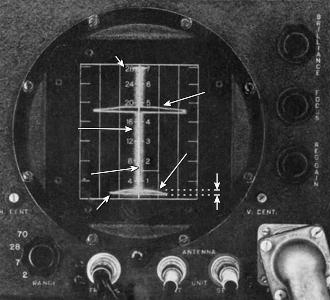Radar L- Scope

Blip
break through
Figure 1: L-Scope, rotated vertically

Blip
break through
Figure 1: L-Scope, rotated vertically
Radar L- Scope
The L-Scope uses deflection modulation like the A-scope. The difference between the two kinds of scopes is that the L-scope shows two video channels on different sides of the base line. One channel as positive deflection, the second one as negative deflection in time-division multiplexing. Since the receiving antennas point in slightly different directions, the difference between the shown lobes contents an azimut information. In Figure 1, at the range of about 18 km, the target in the right part of the deflection is slightly larger than in the left part. This shows, that the aim is slightly right of the direction of flight.
L-scopes have previously been used in air-based fire control radars. Here they were usually installed twisted by 90 degrees. The direction of the trace deflection (range scale) was thus equal to the direction of flight. A target further away on the L-Scope was also further away from the own position.
The breakthrough transmitter pulse and the sea-return gave an overview about the own altitude.
